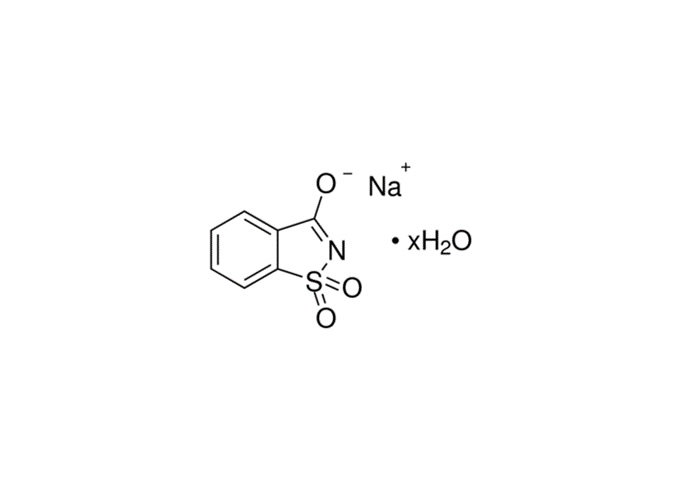| Weight | 5 kg |
|---|
Saccharin Sodium Excipient | Uses, Suppliers, and Specifications
Saccharin is a synthetic, white, crystalline powder, that contains the -CONHSO2– (N-sulfonyl amide) structural unit, common to several compounds with a sweet taste. In its pure state, saccharin is 300 – 600 times sweeter than sugar. Sodium saccharin is the sodium salt of saccharin and occurs as a white odourless or faintly aromatic efflorescent, crystalline powder.
Physicochemical Properties
| Physical form | Solid, powder |
| Acidity/alkalinity | pH = 6.6 (10% w/v aqueous solution) |
| Log P | 0.45 |
| pKa | 1.94 at 25 oC |
| Density (bulk) | 0.8 – 1.1 g/cm3 (76% Saccharin sodium); 0.84 g/cm3 (84% Saccharin sodium) |
| Density (tapped) | 0.9 – 1.2g/cm3 (76% Saccharin sodium); 0.86 g/cm3 (84% Saccharin sodium) |
| Density (true) | 1.7 g/cm3 (84% Saccharin sodium) |
| Melting point oC | Decomposes |
| Dissociation constant | pKa = 1.6 at 25 |
| Heat of combustion | 3644.3Kj/mol |
| Moisture content | Saccharin sodium 76% contains 14.5% w/w water; saccharin sodium 84% contains 5.5% w/w water. During drying, water evolution occurs in two distinct phases. The 76% material dries under ambient conditions to approximately 5.5% moisture (84% saccharin sodium); the remaining moisture is then removed only by heating |
| Solubility | Soluble in water, ethanol, acetone, propylene glycol and glycerin |
| Specific surface area | 0.25m2/g |
Applications in Pharmaceutical Formulations
Saccharin sodium is an intense sweetening agent used in beverages, food products such as tablets, powders, medicated confectionery, gels, suspensions, liquid and mouthwashes. It is suitable for use vitamin and other dietary supplements.
Typical usage levels are shown below:
| Use | Concentration (%) |
| Dental paste/gel
IM/IV injections Oral solutions Oral syrups |
0.12 – 0.3
0.9 0.075 – 0.6 0.04 – 0.25 |
Saccharin sodium is considerably more soluble in water than saccharin and is more frequently used in pharmaceutical formulations. Its sweetening power is approximately 300 – 600 times that of sucrose. Saccharin sodium enhances flavor systems and may be used to mask some unpleasant taste characteristics.
Injection of saccharin sodium has been used to measure the arm to tongue circulation time.
Pharmacopoeial Specifications
| Test | Specification | Reference |
| Identification | A, B, C, D, E | USP-NF/PhEur |
| Characters | White, crystalline powder or colourless crystals | USP-NF/PhEur |
| Appearance of solution | + | USP-NF/ PhEur |
| Acidity or alkalinity | + | |
| o and p-Toluenesulphonamide | + | USP-NF/PhEur |
| Heavy metals | ≤ 20 ppm | USP-NF/PhEur |
| Readily carbonizable substances | + | USP-NF/PhEur |
| Benzoic and salicylic acids | + | USP-NF/PhEur |
| Melting range | ≤ 5ppm | USP-NF/PhEur |
| Loss on drying | ≤1.0% | USP-NF/PhEur |
| Water | ≤ 15.0% | |
| Assay (dried basis) | 99.0 – 101.0% | USP-NF/PhEur |
Safety and Regulatory Status
Saccharin sodium is listed in the pharmacopoeia. It is also accepted for use as a food additive in Europe. Note that the E – number “E954” is applied to both saccharin and saccharin salts. Saccharin is also included in the FDA Inactive Ingredients Database (oral solutions, syrups, tablets and topical preparations). A specification for saccharin is contained in the Food Chemicals Codex (FCC).
There has been considerable controversy concerning the safety of saccharin which has led to extensive studies since the mid-1970s.
There has been considerable controversy concerning the safety of saccharin and saccharin sodium in recent years; however it is now generally regarded as a safe, intense sweetener. See saccharin for further information.
The WHO has set a temporary acceptable daily intake of up to 2.5mg/kg body weight for saccharin, including its salts. In the UK, the committee on Toxicity of Chemicals in Food, Consumer Products, and the Environment (COT) has set an acceptable daily intake for saccharin and its salts (expressed as saccharin sodium) at up to 5mg/kg body weight.
LD50 (mouse, oral): 17.5g/kg
LD50 (rat, IP): 7.1g/kg
LD50 (rat, oral): 14.2g/kg
Stability and Storage Conditions
Saccharin sodium is stable under the normal range of conditions employed in formulations. Only when it is exposed to a high temperature (125) at a low pH (pH 2) for over 1 hour does significant decomposition occur. The 84% grade is the most stable form of saccharin sodium since the 76% form will dry further under ambient conditions. Solutions for injection can be sterilized by autoclave.
Saccharin sodium should be stored in a well – closed container in a dry place.
Saccharin sodium does not undergo mallard browning
Handling Precautions
Observe normal precautions appropriate to the circumstances and quantity of material handled. Eye protection and a dust mask are recommended.
References
[1] T.A. Biemer, Analysis of saccharin, acesulfame-K and sodium cyclamate by high-performance ion chromatography, Journal of Chromatography A, 463 (1989) 463-468.
[2] A.M. Bertorelli, J.V. Czarnowski-Hill, Review of present and future use of nonnutritive sweeteners, The Diabetes Educator, 16 (1990) 415-420.
[3] A. Mortensen, Sweeteners permitted in the European Union: safety aspects, Scandinavian Journal of Food and Nutrition, 50 (2006) 104-116.
[4] K. Woertz, C. Tissen, P. Kleinebudde, J. Breitkreutz, Taste sensing systems (electronic tongues) for pharmaceutical applications, International Journal of Pharmaceutics, 417 (2011) 256-271.
[5] C. Shortt, Authorised EU health claims for intense sweeteners and sugar replacers, Foods, Nutrients and Food Ingredients with Authorised Eu Health Claims, Elsevier2014, pp. 151-176.
[6] J. Walsh, A. Cram, K. Woertz, J. Breitkreutz, G. Winzenburg, R. Turner, C. Tuleu, I. European Formulation, Playing hide and seek with poorly tasting paediatric medicines: do not forget the excipients, Advanced Drug Delivery Reviews, 73 (2014) 14-33.
[7] P.J.C. Sheskey, Walter G; Cable, Colin G, Handbook of Pharmaceutical Excipients – 8th Edition, Pharmaceutical Development and Technology, 18 (2017) 544-544.
[8] T.U.S.P. Convention, Food Chemicals Codex (11th Edition), (2018).


